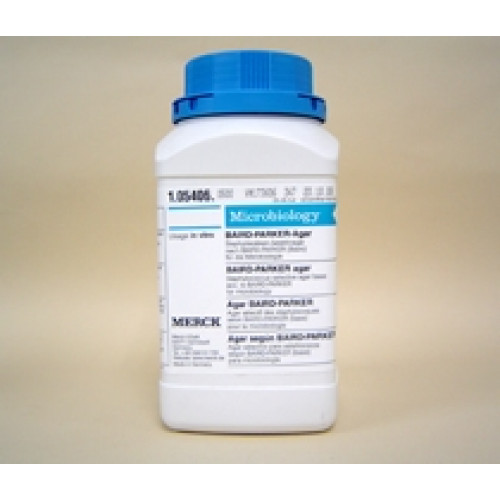ENDO AGAR (AGAR TIPO C) GRANULADO MERCK - EMB 500G
Modelo: 1040440500
-
R$1.289,81
ou até 3x de R$429,94 sem juros
Economize 5% no PIX: R$1.225,32
ou 3.5% no boleto: R$1.244,67
Consulte aqui o valor do frete e prazo de entrega
Descrição
ENDO AGAR (AGAR TIPO C) GRANULADO MERCK
RENDIMENTO 39,0g/l SEG STANDARD METHODS (1992)
Embalagem 500g.
This medium complies with the "Standard Methods for the Examination of Water and Wastewater" (1992).
Mode of Action
Sodium sulfite and fuchsin inhibit the growth of gram-positive bacteria. E. Coli and coliform bacteria metabolize lactose with the production of aldehyde and acid. The aldehyde liberates fuchsin from the fuchsin-sulfite compound, the fuchsin then colours the colonies red. In the case of E. coli, this reaction is so intense that the fuchsin crystallizes out giving the colonies a permanent greenish metallic sheen (fuchsin sheen). Lactose-
negative and wealkly lactose-positive E. coli do not show any fuchsin sheen.
Typical Composition (g/litre)
Peptones 10.0;
di-potassium hydrogen phosphate 2.5;
lactose 10.0;
sodium sulfite, anhydrous 3.3;
pararosanilin (fuchsin) 0.3;
agar-agar 12.5.
Preparation
Suspend 39 g/litre, autoclave (15 min at 121 °C), pour plates.
The plates are clear and pale pink.
If the culture medium is somewhat too red after it has solidified, the red colouration can be removed by adding a few drops (max. 1 ml/litre) of a freshly prepared 10 % sodium sulfite solution and
then boiling.
pH: 7.4 ± 0.2 at 25 °C.
On exposure to oxygen the plated culture medium gradually becomes red due to the oxidation of sulfite and can thus no longer be used. It can only be kept for a few days even if it is stored in the dark and at refrigerator temperature.
RENDIMENTO 39,0g/l SEG STANDARD METHODS (1992)
Embalagem 500g.
This medium complies with the "Standard Methods for the Examination of Water and Wastewater" (1992).
Mode of Action
Sodium sulfite and fuchsin inhibit the growth of gram-positive bacteria. E. Coli and coliform bacteria metabolize lactose with the production of aldehyde and acid. The aldehyde liberates fuchsin from the fuchsin-sulfite compound, the fuchsin then colours the colonies red. In the case of E. coli, this reaction is so intense that the fuchsin crystallizes out giving the colonies a permanent greenish metallic sheen (fuchsin sheen). Lactose-
negative and wealkly lactose-positive E. coli do not show any fuchsin sheen.
Typical Composition (g/litre)
Peptones 10.0;
di-potassium hydrogen phosphate 2.5;
lactose 10.0;
sodium sulfite, anhydrous 3.3;
pararosanilin (fuchsin) 0.3;
agar-agar 12.5.
Preparation
Suspend 39 g/litre, autoclave (15 min at 121 °C), pour plates.
The plates are clear and pale pink.
If the culture medium is somewhat too red after it has solidified, the red colouration can be removed by adding a few drops (max. 1 ml/litre) of a freshly prepared 10 % sodium sulfite solution and
then boiling.
pH: 7.4 ± 0.2 at 25 °C.
On exposure to oxygen the plated culture medium gradually becomes red due to the oxidation of sulfite and can thus no longer be used. It can only be kept for a few days even if it is stored in the dark and at refrigerator temperature.







